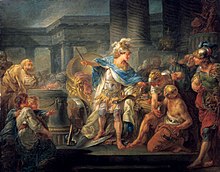Ancient Greek Coin of THRACE, CABYLE
under Celtic Gaul King Cavarus of
Alexander III the Great (336-323 BC)
Struck circa 225-215 BC.
Posthumous Issue in the name and types of Alexander III the Great of Macedon under Cavarus
Silver AR Tetradrachm (30mm, 11h)
Reference: Price 882 , Peykov F2010
Certification: NGC Choice VF 6841504-062
Obverse: Head of Heracles right, wearing lion skin headdress, paws tied before neck
Reverse: ΒAΣIΛEΩΣ / ΑΛΕΞANΔΡOY, Zeus enthroned left, right leg drawn back, feet on ground line, eagle in outstretched right hand, grounded scepter in left; Artemis Phosphoros standing facing with long lit torch in each hand in inner left field.
See the Genuine History Collection
Cavarus was a Celtic king in Thrace and the last king of Tylis. Under Cavarus, Tylis was destroyed by the Thracians in 212 BC.
In 279 BC, the Celtic Gauls swept down into Thrace and Asia Minor, defeating most the Greek armies sent to stop them with ease. They occupied Thrace for the next five decades, replacing the Odrysian rulers with their own succession of kings. The only one of these to strike coinage in his own name was Cavarus (Kavaros), who used Cabyle as his capitol and mint city. The types are those of Alexander the Great, and most of the coins struck under Cavarus have Alexander's name as well; but a few were struck with the name of Cavarus himself. The Gauls of Thrace later mass-migrated into Asia Minor and founded the Galatian Kingdom.
Alexander III of Macedon (Greek: Ἀλέξανδρος Alexandros; 20/21 July 356 BC – 10/11 June 323 BC), commonly known as Alexander the Great, was a king of the ancient Greek kingdom of Macedon. He succeeded his father Philip II to the throne in 336 BC at the age of 20, and spent most of his ruling years conducting a lengthy military campaign throughout Western Asia and Egypt. By the age of thirty, he had created one of the largest empires in history, stretching from Greece to northwestern India. He was undefeated in battle and is widely considered to be one of history's greatest and most successful military commanders.
Until the age of
16, Alexander was tutored by Aristotle. In 335 BC, shortly after his assumption
of kingship over Macedon, he campaigned in the Balkans and reasserted control
over Thrace and Illyria before marching on the city of Thebes, which was
subsequently destroyed in battle. Alexander then led the League of Corinth, and
used his authority to launch the pan-Hellenic project envisaged by his father,
assuming leadership over all Greeks in their conquest of Persia.
Alexander Cuts the Gordian Knot by Jean-Simon Berthélemy (1767)